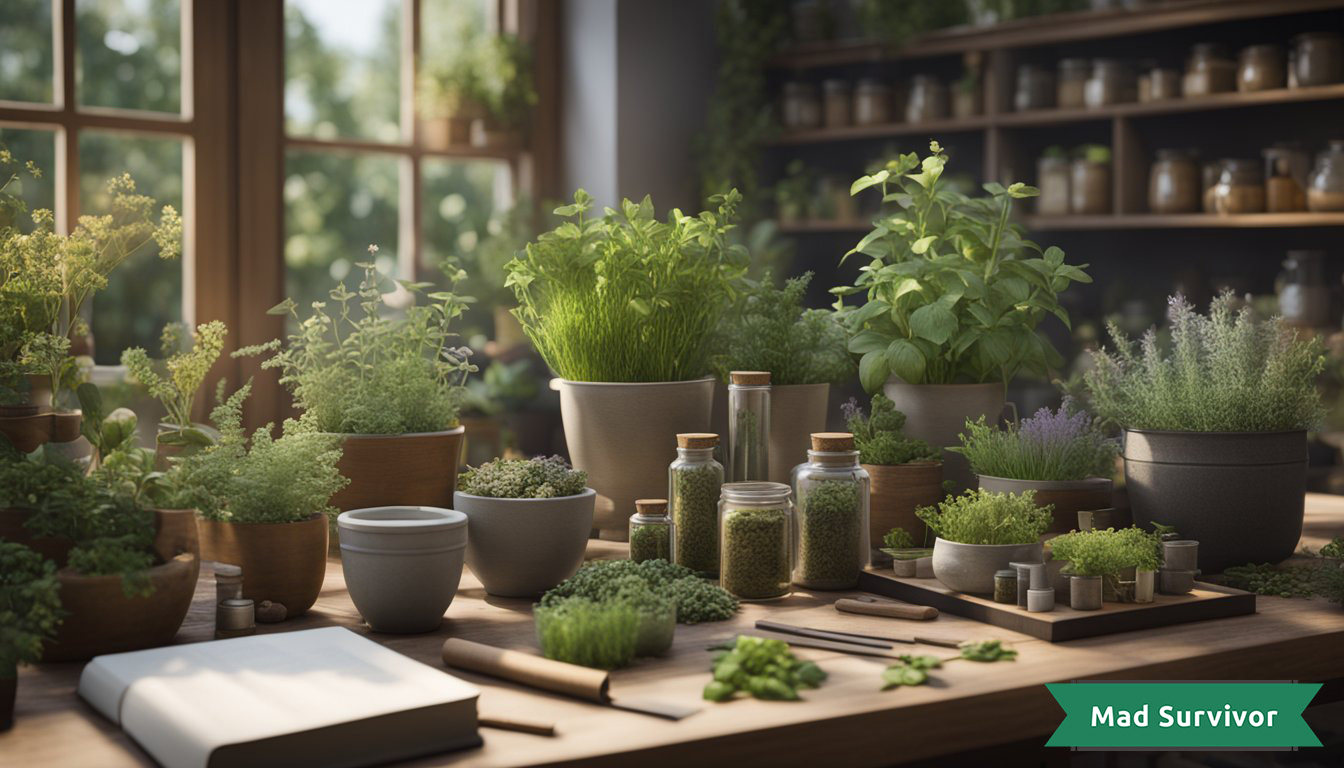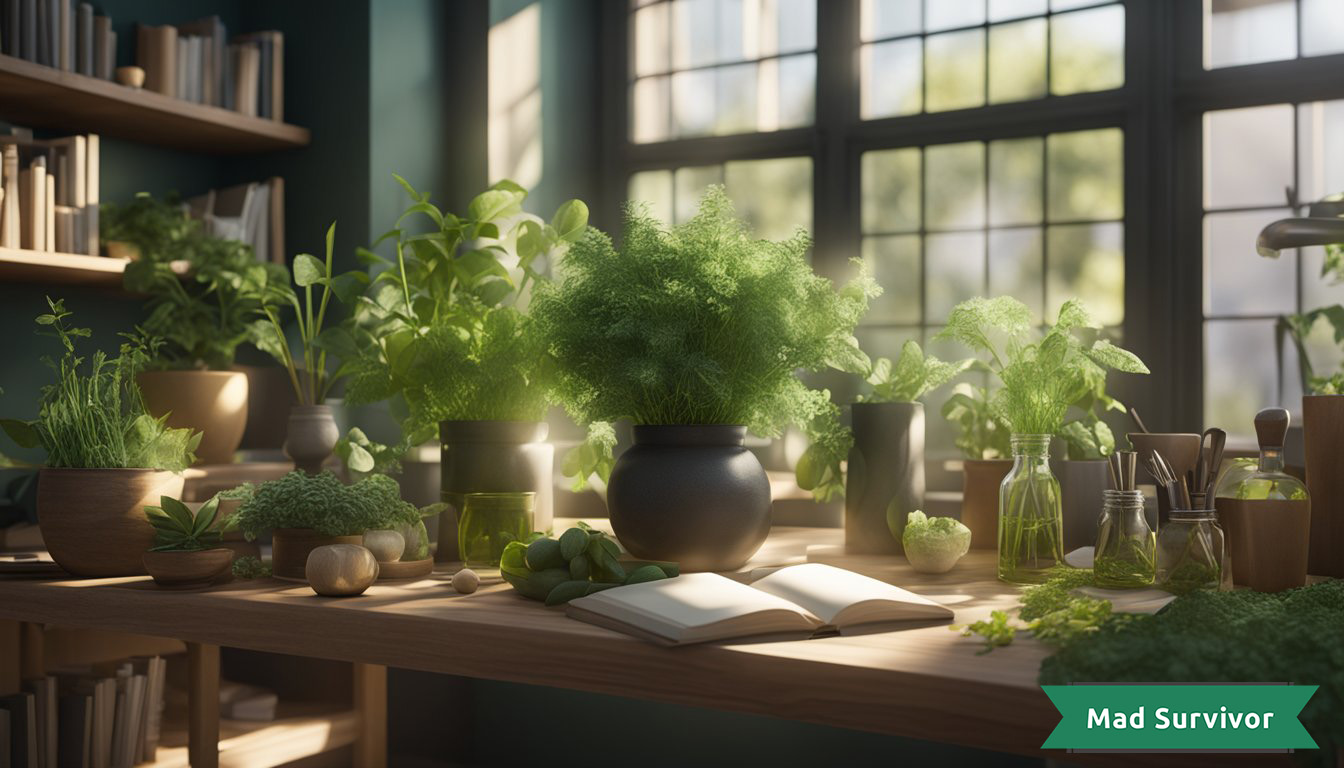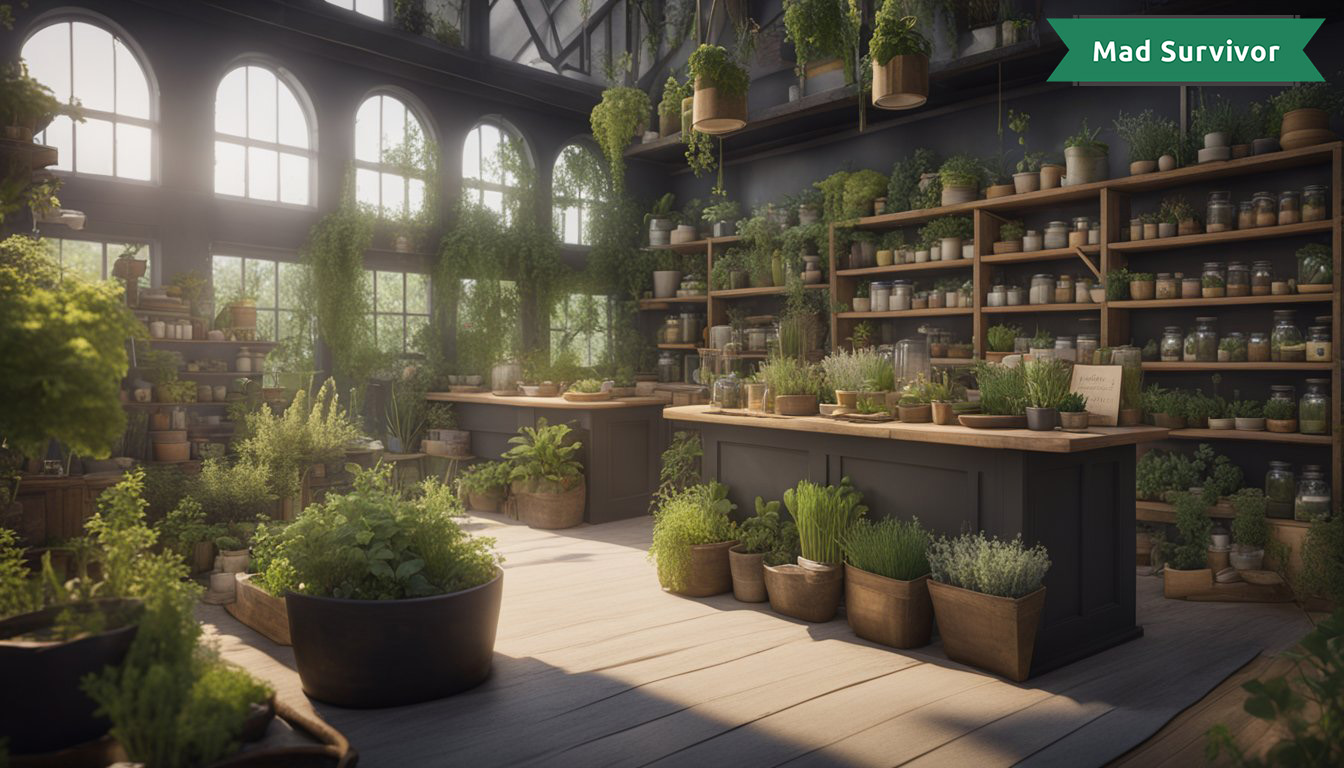
In an age where self-sufficiency and natural remedies are becoming increasingly important, learning to grow your own medicine can be a valuable and empowering skill. Whether for everyday health concerns or preparation for emergencies, cultivating a garden of medicinal herbs offers an alternative to store-bought medications and enhances your survival toolkit. Herbal medicine, with its time-honored traditions, harnesses the healing properties of plants, providing a sustainable way to manage both minor ailments and support overall well-being.
Starting your own medicinal herb garden is simpler than you might think, and it’s an activity that rewards you with more than just health benefits. It connects you to the cycles of nature and encourages a more mindful approach to the use of natural resources. From the vibrant calendula that can soothe your skin to the humble cilantro that aids in detoxification, each plant in your garden can serve a specific purpose in your natural medicine cabinet. You’ll discover how nurturing these plants can, in turn, nurture your health.
As you embark on this journey of growing your own medicine, you’ll find that it is not just about survival but about thriving naturally. Through thoughtful selection of herbs known for their medicinal properties, you can create a safe haven of healing right in your backyard. It’s a step towards self-reliance and a testament to the power of alternative medicine that has been embraced by cultures around the world for centuries.
Jump To Section
- Getting Started with Medicinal Herbs
- Cultivation Techniques
- Health Benefits and Uses
- Safety and Best Practices
- Advanced Tips for Herbal Gardening
- Survival Medicine
- Herb Profiles and Their Benefits
- Herbal Preparations and Recipes
- Conclusion
Getting Started with Medicinal Herbs

Growing your own medicine starts with understanding the basics, selecting the right herbs for your needs, and planning your garden layout.
Understanding the Basics of Herbal Medicine
Before you plant your first seed, it’s important to grasp the fundamentals of herbal medicine. Medicinal herbs, revered for centuries, can provide natural remedies for various ailments. However, their use demands respect and a bit of education to ensure safety. Become acquainted with botanical names, plant parts used, and their healing properties. Remember, some herbs can interact with medications, so seek advice from a healthcare professional if unsure.
Choosing the Right Herbs to Grow
When selecting herbs for your garden, consider:
- Local climate: Ensure the herbs you choose can thrive in your region’s weather conditions.
- Soil conditions: Tailor your soil composition to meet the needs of your chosen herbs.
- Personal needs: Focus on herbs that address specific health concerns you or your family may encounter.
Here are a few versatile medicinal herbs to consider:
- Calendula: Easy to grow, it aids in skin healing.
- Lemon Balm: Known for relieving stress and aiding sleep.
- Peppermint: A digestive aid that can relieve stomach issues.
Planning Your Medicinal Herb Garden
To start your garden:
- Evaluate your space, whether it’s patches of land or container gardens on a balcony.
- Craft a garden design – create pathways and define beds to ensure ease of access.
- Begin with a modest selection of herbs to manage their care effectively.
- Use good quality, non-GMO seeds or starter plants to maximize your garden’s potential.
Your success hinges on attention to detail and a willingness to adjust your strategies as you learn from experience. May your garden flourish, offering both health benefits and the joy of tending to your living medicine chest.
Cultivation Techniques

Creating a medicinal garden requires careful consideration of the environment and knowledge of each plant’s needs. Here, you’ll learn methods to ensure healthy growth, from soil prep to herb preservation.
Soil and Climate Considerations
Your medicinal herb garden’s success starts with the right soil and climate conditions. Herbs generally prefer well-draining soil rich in organic matter. You can improve your soil quality by incorporating compost or aged manure, which also provides essential nutrients. Check the ideal pH for each herb you plan to grow, as some may prefer slightly acidic or alkaline soils. Climate plays a pivotal role; while many herbs thrive in full sun, some require partial shade. Understand your local climate and match herbs that can naturally prosper in those conditions.
Propagating and Growing Herbs
When propagating, you have options such as seeds, cuttings, or divisions. For seeds, start them indoors in trays before the last frost, or sow them directly in your garden at the appropriate time. Cuttings should be taken from healthy parent plants, placed in a suitable growing medium, and kept moist until roots develop. Divisions involve separating mature plants into smaller pieces, each with its root system, which can then be replanted. When growing medicinal herbs, allow space for them to expand—overcrowding can lead to poor air circulation and increased disease susceptibility.
Best Practices for Watering and Maintenance
Consistent watering is crucial for young plants, but be cautious not to overwater, as this can lead to root rot. A general rule is to water deeply but infrequently, encouraging strong root systems. Use mulch to retain moisture and reduce weed competition. Regularly trim or pinch back herbs to promote bushier growth and prevent them from going to seed prematurely, which can halt leaf production.
Harvesting and Preserving Herbs
Harvest herbs early in the morning when their aromatic oils are at their peak concentration. Gather only what you need, leaving enough for the plant to continue growing. To preserve your herbs, you can dry them by hanging in a well-ventilated, dark space or using a dehydrator. Another method is freezing, which works well for herbs like basil or chives. Properly stored, dried herbs can maintain their potency for up to a year, providing you with a steady supply for your medicinal needs.
Health Benefits and Uses

Growing your own medicine with a variety of medicinal herbs can be a game-changer for your health and survival skills. You’ll not only cultivate plants that can aid with immunity and digestion but also learn to harness these natural remedies for pain relief and other common ailments. Let’s explore the medicinal properties of these plants, how to prepare remedies, and their practical uses.
Medicinal Properties of Common Herbs
Herbal medicinals are valued for their ability to treat and prevent a range of health issues.
- Calendula: Known for its wound-healing properties, calendula can be applied topically for burns and cuts or taken internally for digestive health.
- Cilantro: A versatile herb aiding in digestion and heavy metal detoxification.
- Licorice: A root that is more than candy, offering cough relief and gastrointestinal comfort.
Most of these herbs can be brewed into teas or made into tinctures, which are potent and convenient ways to consume them.
Preparing Herbal Remedies at Home
You can transform these herbs into teas, tinctures, or salves with simple recipes:
- Teas: Steep the leaves or flowers of your chosen herb in hot water. For instance, a spoonful of crushed calendula petals in a cup of hot water can soothe an upset stomach.
- Tinctures: Soak herbs in alcohol or vinegar to extract their benefits more fully. Licorice root tincture, for example, when taken in small doses, can ease sore throats.
- Salves: Combine infused oils from herbs with beeswax to create a healing salve, perfect for topical skin issues.
Remember, precise measurements and appropriate storage are key for potency and safety.
Using Herbs for Common Ailments
Adopting natural remedies in your daily routine can effectively bolster your health. For example:
- Immune Support: Echinacea can be a powerful ally during cold and flu season.
- Digestion: Peppermint and ginger teas can calm an upset stomach.
- Pain Relief: Willow bark, the natural source of aspirin, can be used to lessen pain.
Integrating these herbs into your healthcare regimen could help manage symptoms and potentially reduce the need for over-the-counter medications.
Safety and Best Practices

When growing your medicinal garden, prioritizing safety and best practices is essential. Your health and well-being can greatly benefit from incorporating natural remedies into your survival toolkit, but it’s important to do so with informed caution.
Consulting with Medical Professionals
Before embarking on using herbs for medicinal purposes, consult with a medical professional. They can offer guidance based on your health history and current condition, ensuring that any herbal supplements you consider are appropriate for educational purposes or personal use.
- Research: Gather information from reputable sources to discuss with healthcare providers.
- Educate Yourself: Understand the basics of medicinal plants use to make the most of your consultation.
Understanding Potential Side Effects
Every natural remedy has the potential to cause side effects, and these can vary from person to person. Carefully research the plants you wish to grow and be aware of:
- Common Side Effects: Documented reactions that medical professionals have recognized.
- Personal Sensitivities: Track how you respond to different herbs, as individual experiences may differ.
Responsible Use of Herbal Medicine
Herbs can be potent, so it’s vital that you use them responsibly:
- Dosage: Follow recommended amounts; more is not always better.
- Combining Herbs: Be cautious about mixing herbs without professional advice, as interactions may occur.
- Long-Term Effects: Monitor your ongoing use and any changes in your health over time.
Ensure your journey into medicinal gardening is both safe and rewarding by staying informed and careful.
Advanced Tips for Herbal Gardening

Gardening with a focus on medicinal herbs requires consideration for the unique challenges and benefits they bring. From keeping your plants healthy amidst pests and diseases, to ensuring they’re well-pollinated, to learning the trade secrets from seasoned herbalists, here’s how you can advance your herbal green thumb.
Dealing with Pests and Diseases
Pests and diseases can be a significant hindrance to your medicinal garden’s health and yield.
- Identify Pests Early: Regularly check your herbs for signs of insects. Early detection can prevent widespread damage.
- Natural Remedies: Employ natural pest control methods. For example, neem oil can combat various pests and fungal issues without harming beneficial insects.
- Disease Resistance: Opt for disease-resistant herb varieties when possible. This proactive measure can lessen your garden’s vulnerability to common ailments.
Attracting Pollinators
Pollinators like bees are crucial to your garden’s success.
- Plant Variety: Integrate a variety of flowering plants to bloom throughout the growing season to keep pollinators returning.
- Avoid Pesticides: If you must use pest control, choose times when pollinators are less active and opt for substances that won’t harm them.
- Provide Habitat: Leaving some bare soil and water sources can create a hospitable environment for pollinators.
Learning from Expert Herbalists
To truly excel in herbal gardening, learn from those with experience.
- Join Communities: Participate in herbalist forums or local groups. Sharing experiences can lead to gaining valuable insights.
- Study Resources: Invest time in reputable books or online courses tailored to medicinal herb cultivation and use.
Survival Medicine

In the event of emergencies or off-grid living, knowing how to harness the power of medicinal plants can be a life-saving skill. Whether you’re managing minor wounds on a hiking trail or preparing your home for potential SHTF (Shit Hits The Fan) scenarios, understanding survival medicine is essential.
Identifying Wild Medicinal Plants
To safely use wild medicinal plants, you first need to identify them correctly. Start by familiarizing yourself with local flora and studying authoritative guides. It’s vital to know:
- Leaf Shape: Determines the type of plant.
- Color: A vibrant color can indicate usability.
- Smell: Often unique to medicinal plants.
Avoid: plants with white sap, thorns, or fine hairs unless you’re certain of their medicinal uses.
Preparing for Emergencies with Herbal Medicine
Prepare your survival kit with the essentials:
- Dried Herbs: Store them properly for longevity.
- Tinctures and Extracts: Concentrated and long-lasting.
- Salves: Ideal for skin issues and wounds.
Understand the preparation of:
- Teas: Boiling water steeped with herbs.
- Infusions: Stronger than teas, often for topical use.
- Poultices: Crushed plant parts applied directly to the skin.
Natural Remedies for Travel and Outdoor Adventures
Pack a portable kit including:
- Elderberry Syrup: For immune support.
- Cilantro Tincture: Detoxifying heavy metals.
- Peppermint Oil: For digestive issues and headaches.
Be ready to:
- React: Knowing which remedy to use for common ailments.
- Adapt: Using available plants when your supplies run low.
By equipping yourself with this knowledge and preparation, you can confidently handle many health concerns with natural remedies during your outdoor activities or in survival situations.
Herb Profiles and Their Benefits

Discovering the diverse array of medicinal herbs can transform your approach to health. Each herb offers unique benefits, from stress relief to immune support, and growing them at home can be both practical and fulfilling.
Chamomile: For Sleep and Stress Relief
Chamomile is renowned for its calming properties. Sipping chamomile tea before bed can ease you into a restful sleep and can also help reduce stress levels.
Basil: The Anti-Inflammatory Powerhouse
Basil contains compounds that have anti-inflammatory effects. Integrating basil into your meals may help alleviate inflammation related to arthritis and gut issues.
Mint: Soothing Digestion and Headaches
A versatile herb, mint not only freshens breath but is also a digestive aid. A menthol component makes it your ally in soothing headaches too.
Lavender: Calming Nerves and Skin Care
Lavender’s pleasant fragrance has sedative qualities, making it a natural choice for nerve calmness. It can also be applied as an essential oil for skin care.
Lemon Balm: Mood Improvement and Antiviral Effects
Lemon balm is a mood booster that potentially offers antiviral benefits. Add it to tea or salads to enjoy its uplifting effects.
Thyme: From Coughs to Antifungal Applications
Thyme acts as an expectorant for coughs and possesses antifungal properties. It’s beneficial in treating sore throats and other respiratory issues.
Oregano: For Respiratory Health and Antimicrobials
Packed with antimicrobial constituents, oregano can bolster your respiratory health and is useful in fighting off colds.
Echinacea: Immune System Booster and Common Cold Ally
Echinacea is prominent as an immune system booster. Use it at the onset of cold symptoms to help your body fight off the illness sooner.
Peppermint: Beyond Fresh Breath – Digestive Aid
Beyond its breath-freshening prowess, peppermint is trusted for easing digestive issues such as indigestion and gas.
Valerian: Nature’s Sedative and Anxiety Reducer
Valerian root is respected for its sedative qualities. It can offer natural relief from insomnia and anxiety, promoting better sleep.
Turmeric: Fighting Inflammation and Heart Disease
Turmeric, with its active compound curcumin, provides strong anti-inflammatory benefits and can enhance heart health.
Garlic: Nature’s Antibacterial and Cholesterol Reducer
Garlic, with its antibacterial properties, can act against various infections and also aids in reducing blood cholesterol levels.
Rosemary: Memory Enhancer and Muscle Relaxant
Rosemary may support memory enhancement and has been linked to easing muscle tension.
Parsley: Rich in Antioxidants and Vitamins
Parsley is a great source of antioxidants, vitamins A and C, and can bolster your immune system.
Yarrow: Wound Healing and Fever Management
Yarrow is traditionally applied as a poultice to heal wounds, and it can assist in managing fevers due to its diaphoretic properties.
Feverfew: Migraine Mitigator and Arthritis Helper
Feverfew is often employed to reduce migraine headaches and may alleviate arthritis symptoms.
Holy Basil: Stress Reliever and Diabetes Manager
Holy Basil, or Tulsi, is revered in herbal medicine for reducing stress and regulating blood sugar levels, making it valuable for diabetes management.
Herbal Preparations and Recipes
In your journey to grow your own medicine, learning how to create effective herbal preparations is fundamental. These techniques will enable you to harness the natural benefits of plants for your health and well-being.

Making Tinctures and Extracts
Tinctures are concentrated herbal extracts made by soaking herbs in alcohol or vinegar. This method extracts the active compounds from herbs and preserves them for long-term use. To make a tincture:
- Chop your chosen herb finely.
- Place the herb in a clean jar, covering it with vodka or apple cider vinegar.
- Seal the jar and store it in a cool, dark place for up to six weeks, shaking it daily.
- After steeping, strain the mixture and store it in a dark glass dropper bottle for easy use.
Creating Salves and Poultices
Salves are thick creams used to soothe skin conditions and support healing. Poultices are moist substances applied directly to the skin to address soreness or inflammation.
To create a salve:
- Melt beeswax in a double boiler.
- Mix in infused oils such as comfrey or St. John’s Wort and stir until well-blended.
- Pour into containers and allow to cool before sealing.
For a poultice:
- Crush fresh or dried herbs into a paste.
- Spread the paste directly onto the affected area or on a cloth before applying.
- Wrap gently with gauze to hold the poultice in place.
Cooking with Medicinal Herbs
Herbs can be a flavorful and therapeutic addition to your meals. Incorporate herbs like turmeric, which is known for its anti-inflammatory properties, into your recipes.
- Use the root cuttings of turmeric in curries or teas.
- Sprinkle dried herbs over your dishes for an extra boost of flavor and health benefits.
- Remember to start with small amounts to gauge taste and effect.
Storing Herbs for Long-Term Use
Proper storage extends the shelf life of your medicinal herbs, ensuring they retain potency.
- Dry herbs by hanging them in a cool, dark place or using a dehydrator.
- Store dried herbs in airtight containers, away from direct light and heat.
- Label containers with the name and date to keep track of your stock.
Conclusion

Growing a medicinal garden offers a blend of therapeutic benefits and practical advantages for your self-sufficiency goals. By nurturing annual plants with healing properties, you cultivate not only a natural pharmacy for conditions like the common cold or heart disease, but also a source for natural medicine that can serve as pain killers.
- Heart Disease: Plants such as Garlic and Hawthorn are known for their heart-healthy benefits.
- Common Cold: Echinacea and Elderberry can support the immune system.
- Pain Relief: Options like Willow bark and Turmeric serve as natural analgesics.
Your homegrown medications, harvested right from your garden, can foster a stronger connection to nature and a deeper understanding of plant-based remedies. Preparedness is more than survival; here’s how you’ve strengthened your readiness by creating your very own medicinal garden:
- Health Empowerment: You’ve taken control of wellness with remedies for basic ailments.
- Economic Savings: Growing your own reduces reliance on commercial pharmaceuticals.
- Environmental Conservation: Your garden supports biodiversity and nurtures the ecosystem.
With your hands in the soil, you nurture a living pharmacy. This experience is not just about survival; it’s about thriving with the knowledge that your garden’s yield can play a role in maintaining health and well-being.

Leave a Reply